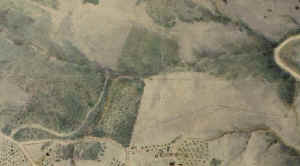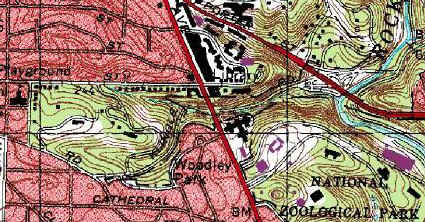| Klingle
Valley, Rock Creek Park, DC |
Darian
Copiz |
| Jan
05, 2006 10:58 PST |
Please
forgive the lenghthy description. The first three of the
following paragraphs are an introduction to Rock Creek Park,
after which
discussion of the specific site begins.
Rock Creek Park is the oldest and largest urban park in the
National
Park system. During the Civil War, President Lincoln spent much
time in
a cottage on the grounds of what is now the Soldier's and
Airmen's Home.
This demonstrated the need for a presidential retreat within
Washington.
Nathaniel Michler of the Corps of Engineers was commissioned to
compile
a report with the purpose of finding a site for a home and
additional
parkland around surrounding it. Michler focused most of his
efforts on
the parkland and ended up proposing a much larger park than had
originally been envisioned. The area he looked at was the valley
and
environs of Rock Creek. His report and map of the creek led to
attempted legislation for the park in 1867. This failed, but
eventually
did become a reality in 1890. The original park consisted of
over 1,700
acres. It is now over 2,000 acres and includes many of the
surviving
tributaries of Rock Creek.

Klingle Valley portion of the 1867 Michler map of Rock Creek,
Library of Congress
Although Washington D.C formally became a city in 1801,
Georgetown,
which is encompassed within the District was settled in 1696.
The
capital city was not built on virgin land, but on farmland. Some
parts
of the city were likely farmed by previous Native Americans as
well. At
the time Rock Creek Park became a reality, much of the uplands
were in
agricultural use but most of the stream valleys were wooded.
Although
settlers had been in the area for almost 200 years before the
park's
creation it is possible that some areas were relatively
untouched. One
National Park Service site I came across stated that the trees
along
Melvin Hazen Branch are 150 to 300 years old, signifying that at
least
in that location some of the trees may be pre-settlement.
Michler, in
his 1867 report described parts of the park as "thickly
mantled primeval
forest" and stated that there was "already large
growth of trees and
shrubs".

"Klingle Valley, USGS"
Rock Creek cuts through the piedmont before it empties into the
Potomac
River at Georgetown, the bottom of the fall zone. In Washington
D.C.,
much of the creek winds through steep valleys with numerous
tributaries
feeding into it. Some of these tributaries are now piped
underground or
dried up, but those that remain are usually heavily wooded
although
many, as well as the Rock Creek valley as well, have roads
running
through them. The District receives an average of about 40
inches of
precipitation a year. Soils are primarily
slightly acidic loams and
gravelly loams. Almost all streams in the park are subject to
flash
flooding and erosion. Additionally the stream valleys contend
with foot
traffic, invasive species, and air and rainwater pollutants.
On December 24th and January 2nd I visited one of the tributary
stream
valleys, Klingle Valley. This valley is on the west side of Rock
Creek,
abuts the north end of the National Zoo and is the next
tributary valley
south of the Melvin Hazen Valley. The valley has a highly eroded
stream
and an old road running through it. The road was closed in 1991,
but
there are current plans to rebuild it. Reconstruction will most
likely
remove many of the trees along the stream and the road. Some of
the
trees measured are actually located on the Washington
Interantional
School grounds which is on the hill between the two branches of
the
stream valley. The soil in the valley is gravelly loam with
practically no humus. There is little understory or new
saplings. In
the north branch of the valley (school grounds) there are a
large number
of rhododendrons which were most likely planted as part of a
natural
garden for the adjacent mansion (now the school). The tallest
trees
(tuliptrees) are located at the confluence of the two branches,
but more
closely following the northern branch. Tuliptree is by far, the
most
common tree. Beech is also common. Chestnut and Red are the oaks
occuring most frequently. Sycamore and ash occur intermittently
along
the stream. The valley has two branches to it which I will refer
to as
the north branch and south branch.
Carya glabra 6' 7" x 97.0' only hickory I saw in the valley
Fagus grandifolia 8' 4" x 119.3' near confluence
Fagus grandifolia 7' 5" x 110.7' school grounds
Fraxinus pennsylvanica 8' 10" x 131.4' south branch
Fraxinus pennsylvanica NA x 122.9' measured from Connecticut
Ave.
bridge
Liriodendron tulipifera 9' 5" x 141.3' near confluence
Liriodendron tulipifera 11' 7" x 139.9' south branch
Liriodendron tulipifera 10' 10" x 137.8' near confluence
Liriodendron tulipifera NA x 132.4' measured from Connecticut
Ave.
bridge
Liriodendron tulipifera 11' 6" x 130.8' south branch
Pinus strobus 8' 2" x 107.4'
planted on school grounds
Platanus occidentalis 11' 2" x 135.2' south branch
Prunus serotina 5' 0" x 120.1' south branch
Quercus alba 8' 5" x 112.7'
school grounds
Quercus prinus 10' 1" x 118.4' downstream
of Connecticut Ave.
bridge
Quercus rubra 12' 10" x 131.6'
impressive fluting, cbh
measured at about 6', downstream of Connecticut Ave. bridge
Quercus rubra 10' 3" x 112.5' south
branch
Robinia pseudoacacia 5' 9" x 94.0' south branch
RI: 120.1 (Pinus strobus not included)
I had a difficult time finding 10 species. I found the black
locust
just as I was leaving.
Darian
|
| Re:
Klingle Valley, Rock Creek Park, DC |
Kirk
Johnson |
|
Jan
05, 2006 13:11 PST |
Darian,
Thank you for this description, it brings back memories. I
worked for the
National Park Service in Rock Creek Park during the summer of
1999. There
are some amazing tuliptrees, black & red oaks, sweetgums,
and others
throughout the park, that's for sure! I worked in the invasive
plant control
program when I was there. Invasives are a huge problem in Rock
Creek Park.
Non-native vines such as porcelain berry and Asiatic bittersweet
are
smothering forested portions of that park, as I'm sure you saw.
Non-native
trees such as Norway maple and tree-of-heaven are invading.
Here's a little more background on Rock Creek Park, if anyone is
interested.
This is taken from:
Fleming, Peggy and Raclare Kanal. 1995. Annotated checklist of
vascular
plants of Rock Creek Park, National Park Service, Washington,
D.C. Castanea
60(4): 283-316.
"A total of 656 species representing 374 genera and 106
families were
documented. Of these, 418 species are indigenous and 238 are
introduced."
"The Civil War period marked the beginning of large-scale
direct impact on
Rock Creek Valley. Fort DeRussey and Military Road were built in
and through
present-day Rock Creek Park....To provide site lines for the
guns of the
fort, an area north of Military Road was cleared. Neither the
boundary of
the cleared portion of the park nor the thoroughness with which
the plan was
executed can be determined today. The planned clearing was a
strip one and
one-half miles wide, extending along the entire arc of forts
surrounding the
capital. Surveys made of the park area during the war represent
the area
north of Military Road as a stump field (Engineer Department
1864-1866).
This portion of the park has since succeeded to forest."
"Presently, the Rock Creek park vegetation is mature,
second growth forest.
Previous uses of the land are discernable. Within the forest are
occasional
large oaks, over 275 years old, with low open branching
characteristic of
open grown trees. These trees are probably survivors of small
stands of
original forest. A landscape of farmland interspersed with small
patches of
woods is consistent with descriptions for neighboring Maryland
in 1910."
"Multiple-trunked, old Liriodendron tulipifera are found in
diverse
habitats, which suggests resprouting following timbering or
storms."
Kirk Johnson
|
| RE:
Klingle Valley, Rock Creek Park, DC NEW RUCKER? |
Will
Blozan |
| Jan
05, 2006 15:40 PST |
Great
stuff!
Sounds like some of those trees will bring the RI up for Rock
Creek Park.
Here was my
last trip 1/2005:
Chestnut oak
9'11" x 122.3'
Black oak
9'6" x 129'
White ash
10'2" x 126.3'
Mockernut
4'4" x 121.3
N. red oak (var. rubra) 8'9"
x 135.4'
Pignut hickory
6'1" x 124.9'
Tuliptree
9'3" x 162.5'
American beech
6'7" x 119.4'.
White oak
8'7" x 125.9'
Sycamore
6 x 136.7'
Rucker Index of 130.37
Will
|
|